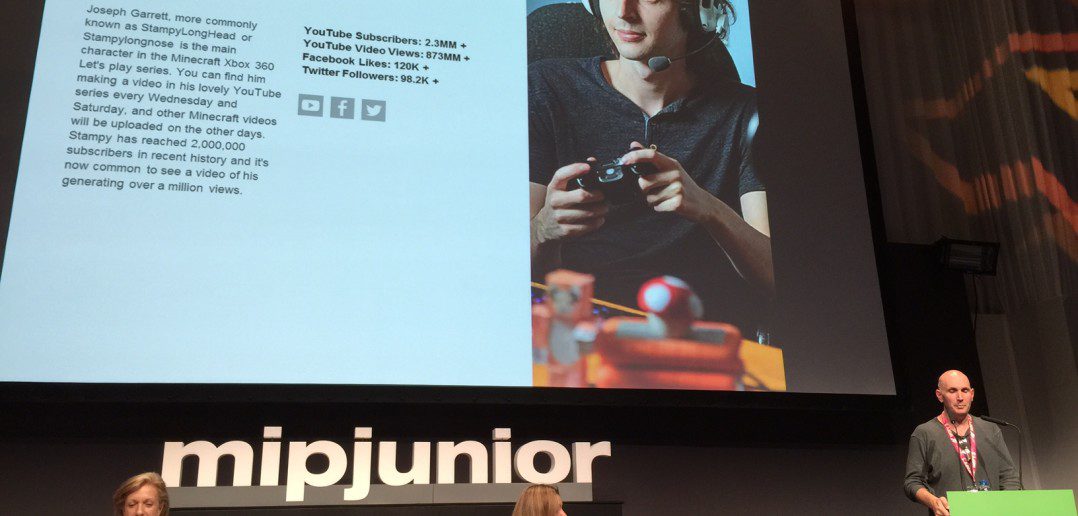Where will the next globally-popular children’s TV brands come from? Perhaps not just from TV. With many new characters and worlds starting life as web videos or apps, digital is proving a fertile spawning ground for new properties.
Today at MIPJunior, the Online Originals for the New Kids on the Block panel discussed how children are seeking out entertainment online, and how creators are providing it for them. The speakers were: Arik Kerman, EVP of programming and digital at BabyFirst; Deborah Forte, president Scholastic Media and EVP of Scholastic Inc; and Michael Ross (photo), general manager of family programming at Maker Studios. The debate was chaired by Sarah Baynes, creative director at The Creative Garden.
Forte kicked off: « I’m actually more optimistic than I’ve been in many years about the business. We’re ready to have a golden age of kids’ content, » she said. « Technology has been an incredible innovator and tool for us, both in terms for kids being able to have many more choices and access to new content. »
She talked about a property called The Magic School Bus, and explained why it debuted as television. « One of the most sustainable ways to launch an IP is television. Or video, I should say, because it’s not always delivered as television. Because it makes a deep connection with the audience that is sustainable, » she said. « It forms a deep emotional connection with kids when they see how the characters feel, how they behave. And that was at the root of Magic School Bus… kids got hooked on the adventures and the stories, the discovery. They became empowered… we were then able to take that foundational platform and build it out across platforms. »
Over to Kerman, who talked about BabyFirst, which targets children aged 0-3 and their parents. Its key channel is available to 81m households across the world, including 43m in the US in English and Spanish. But it also has presences on Netflix, YouTube, Hulu and other digital platforms. It produces original series – more than 75 in the last eight years – with viewers averaging 94 minutes a day. Meanwhile, its BabyFirst Video VOD mobile app has been downloaded more than 1.5m times.
« Let’s not forget that it all starts with good content, » he warned, suggesting that both TV and digital will contribute the children’s classics of tomorrow. « It will be a property that you develop both for TV and for mobile apps, » he said. « Character is key. »
Next up was Maker Studios’ Ross, who talked about how the YouTube multi-channel network is approaching family content. « Our DNA is really accessing over 60,000 creators in our network, who are on YouTube with their own channels, » he said. Stats for its overall business: 7.5bn monthly views, 500m subscribers to Maker’s network of channels, and 70% of its audience is international. « Our kids audience is growing probably the largest out of all our creators, » he said. Family is one of four sectors for Maker: Gaming + Sports, Life + Style and Entertainment are the others.
« You don’t need a bunch of execs sitting in a room to say yes or no. You can put your content up, gain your own audience – gain massive audiences that are about your own passion. They love you for your passion and your authenticity, and not because it comes out of a Disney… I suppose I oughtn’t say that! » Note, Disney acquired Maker Studios earlier this year. But his point was not a criticism of his new bosses: if anything, it was evidence for why Disney is paying up to $950m for the company.
Ross talked about how comfortable children are with new media. « My daughter collates four different streams of things coming at her: she’s on YouTube watching a video, on MiniClips playing a game, she’s communicating with friends on Instagram… this generation is very different. It’s not better or worse, but it’s different from our generation that grew up watching a single stream of content. »
Ross also talked about the creators that Maker Studios works with. « For segments of this millennial generation, these are the new stars. These are the people they love, » he said, referring to Minecraft-gamer Stampy (photo), who had the fourth most popular YouTube channel in the world in August. « He’s like The Beatles to kids aged 10. »
Ross also picked out The Shaytards, Bratayley, Evan Tube HD – who reviews toys. « He’s just very honest and there’s no bullshit about him, and that goes for a lot of these people. They don’t care about to the degree that those of us who come from traditional media care about what advertisers and sponsors think. If they don’t want to do something, they don’t do it. »
« The medium has changed, and therefore the content has changed as well, » he finished, encouraging the MIPJunior audience to explore YouTube as a creative platform. « There’s some amazing things going on there. It’s really important to empower your community and the people who make your content to create on this platform. » And he continued: « IP is not something to hold on to, the way it used to be. You’ve got to let it go. That’s our message to the world: let your content go… It drives a community that lets these brands live and breathe in a way that they just have not done before. »
But Scholastic’s Forte said her company still hasn’t been able to solve the business model issues of funding what it sees as high-quality content by « letting it go completely » – the economics of making more money than you spend can still be tough. Meanwhile, Kerman talked about the need for « cross-media assets » for properties to become the classics of tomorrow: they have to be available on different platforms. « Create as much matching points with your audience, and find the maximum ways they can engage with your content. And be flexible… find the right partners in every medium that will help you. »




